by Jason Bodner
February 13, 2024
It turns out that, according to studies, 20% of the population is indecisive. But leaders tend to make decisions quickly. Indecision can be paralytic and cause more harm than making a wrong decision.
It’s decision time: What do we make of this market? We are at a crux, and we need to decide: Or do we?
If Buy or Sell are “Door #1” and “Door #2,” sometimes investors are best off with Door #3: Do Nothing!
I always say that we can’t trust headlines to make our investing decisions for us. I have long felt that an unemotional data-based approach holds the key to long-term success. So far, after 20 years of investing like this, it hasn’t failed me yet. But sometimes the data can be contradictory and confusing. Now is one of those times. Today, I’ll try to give you some qualitative analysis to the contradictory quantitative data.
Here’s the issue facing us now: the Big Money Index (BMI) has finally fallen from its overbought level. The BMI is a 25-day moving average of unusually large money flows. Basically, we take all unusual buying and unusual selling and net them off into a 25-day average. It looks like this:
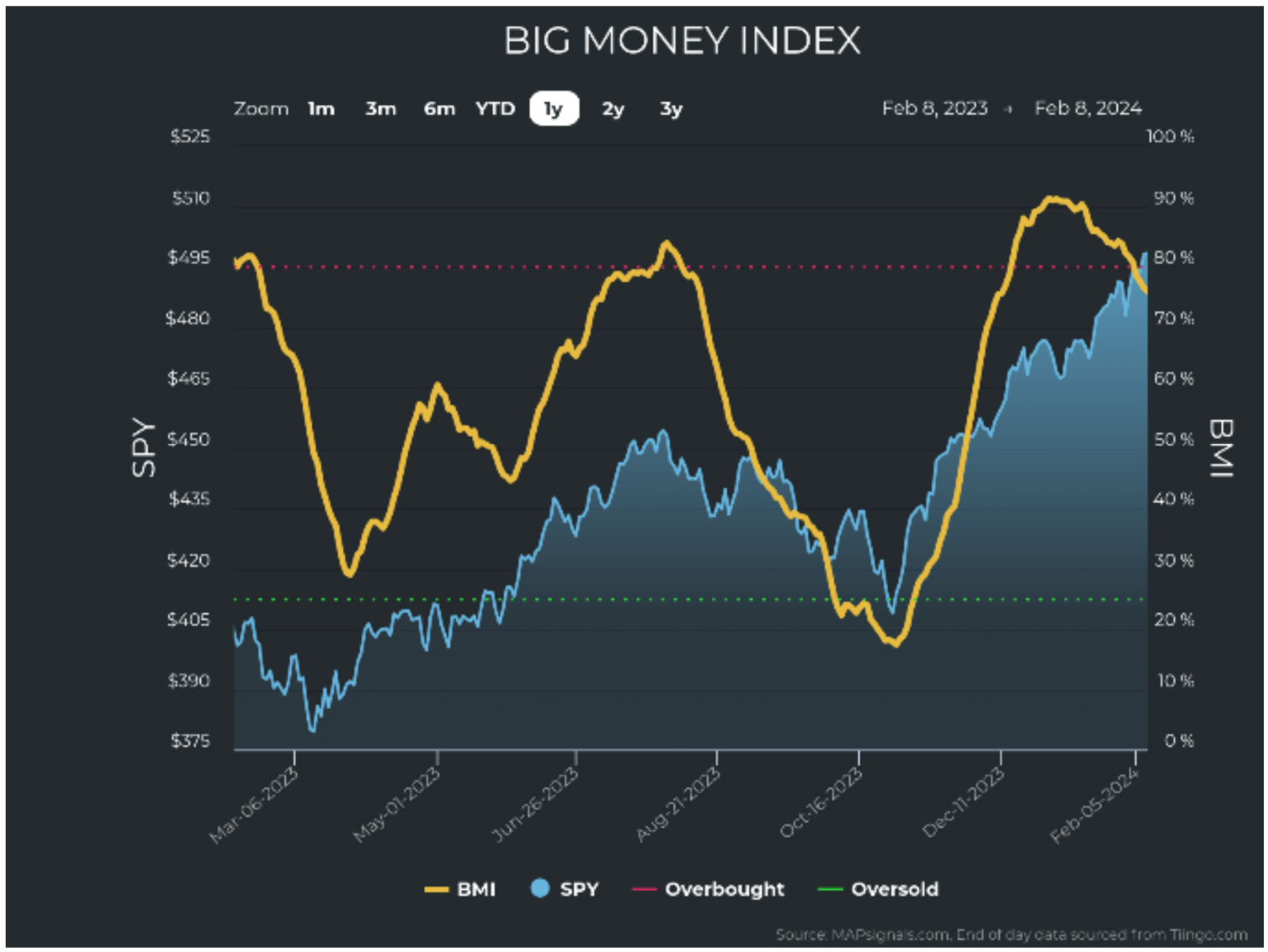
Graphs are for illustrative and discussion purposes only. Please read important disclosures at the end of this commentary.
The blue area is the SPY (the S&P 500 tracking ETF), and the amber line is the BMI. When the BMI rises, money flows into stocks. When it falls, money tends to flow out. When the BMI is above the red horizontal line, that indicates an overbought market: buying is unsustainable, and we expected buying to exhaust at some point. And when the BMI falls from overbought, historically, we expect volatility.
Look at the following chart, showing typical weakness after the BMI falls from overbought since 2009:

Graphs are for illustrative and discussion purposes only. Please read important disclosures at the end of this commentary.
Going back even further, to 1990, we can see that 1-month returns are just slightly over flat – including the latest fall from overbought:

So, what’s so confusing? The market should fall now, right? So far, that’s not happening. In fact, we just hit another all-time high on the S&P 500 and NASDAQ. All is right with the world and stocks are rising.
Not so fast. Throughout history, stock buying and selling move in a cycle. Consulting the chart below, we are somewhere between phase 1 and 2 (closer to 1). This means buying is now just “slowing down”:

Graphs are for illustrative and discussion purposes only. Please read important disclosures at the end of this commentary.
That’s a key point! The BMI is not falling because big money is suddenly rushing out. It doesn’t work that way. The BMI is falling because buying just slowed down. That context is key, because if we look at buying and selling of stocks and ETFs, we notice two things:
1. The immense buying in December recently rolled off the 25-day calculation, making the BMI fall.
2. Clearly, there is no immense selling at this time.
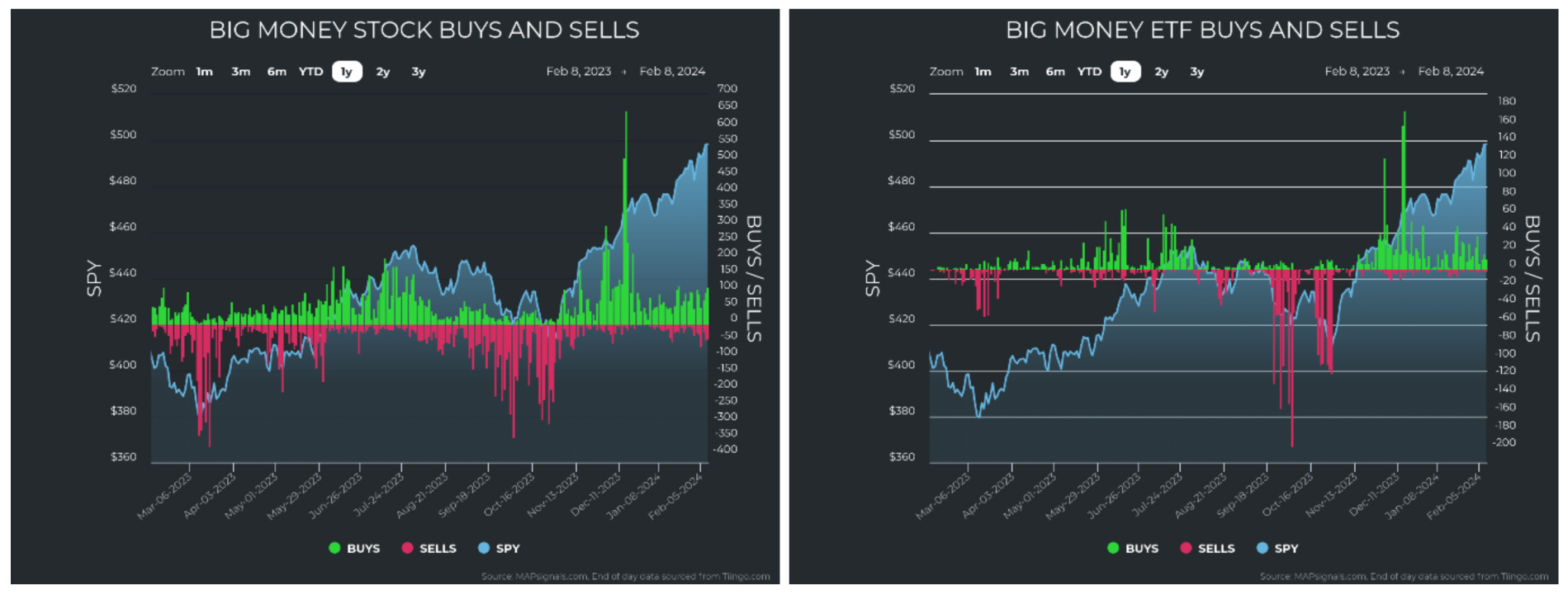
Graphs are for illustrative and discussion purposes only. Please read important disclosures at the end of this commentary.
Volume is drying up at the market top, but look at the chart below: It shows unusually large trades. The rally to highs is not accompanied by dwindling volume. It’s healthy activity pushing indexes higher:
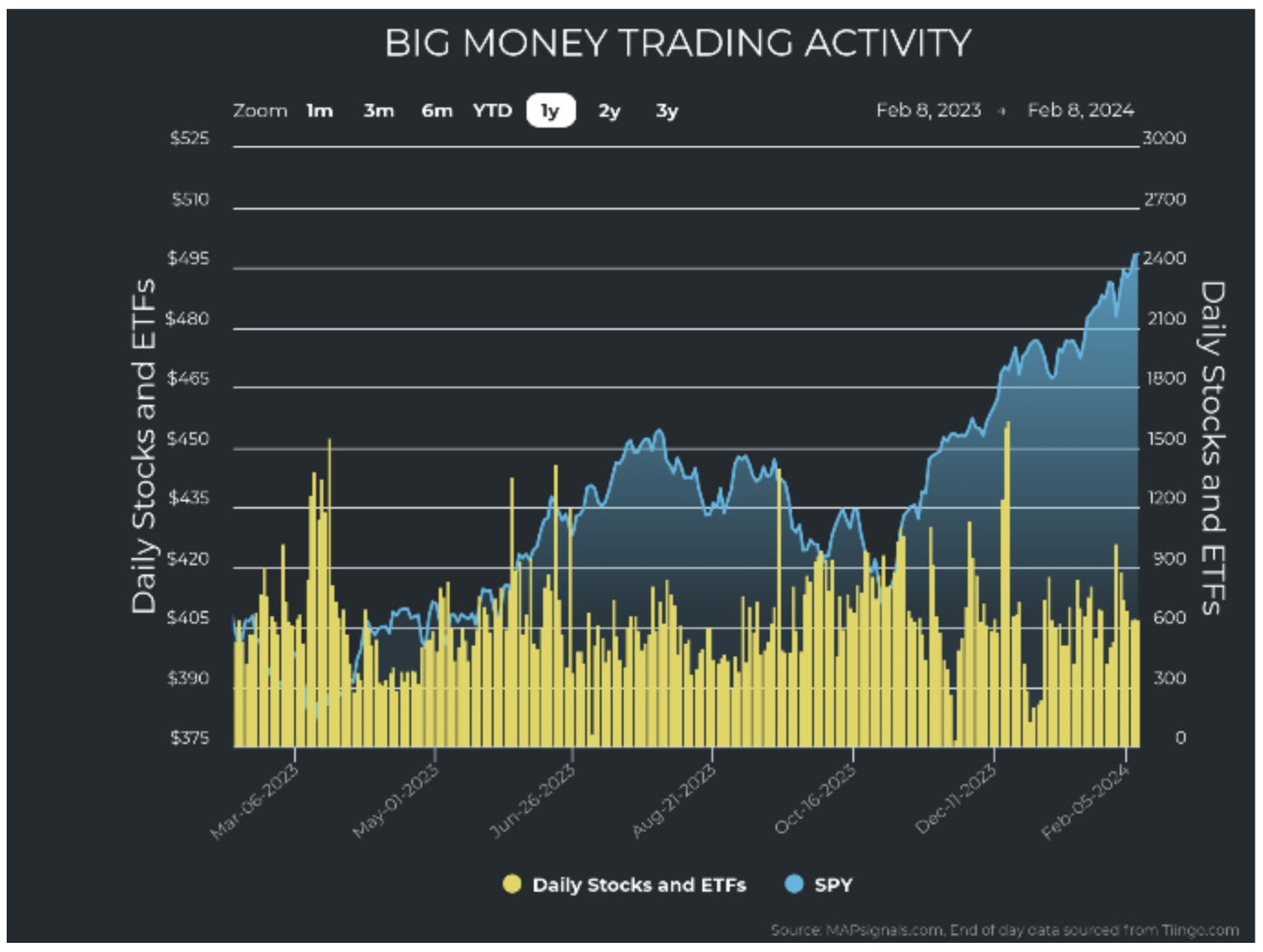
Graphs are for illustrative and discussion purposes only. Please read important disclosures at the end of this commentary.
For now, I am not concerned about an imminent pullback. For this to occur, I’d have to see convincing selling. As of Friday February 9, according the FactSet Earnings Insight, earnings metrics are solid:

With roughly one-third of the S&P 500 still left to report earnings, I think strong earnings will continue. The key now is guidance, since forward-looking statements affect stock prices. In my opinion, downside volatility shouldn’t arrive until earnings season concludes and there is a lull in company specific news.
The BMI says we should expect lower prices. History says that should have already started happening. But given the strength of buying, lack of selling, and the fact that we are only midway through earnings reporting season, I am comfortable riding the wave until we see some indications of increased selling.
Meanwhile, the pockets where we see significant accumulation are very strong bullish signs. First, we see that buying has been heavily focused in small- and mid-caps – a trend we have observed since November.
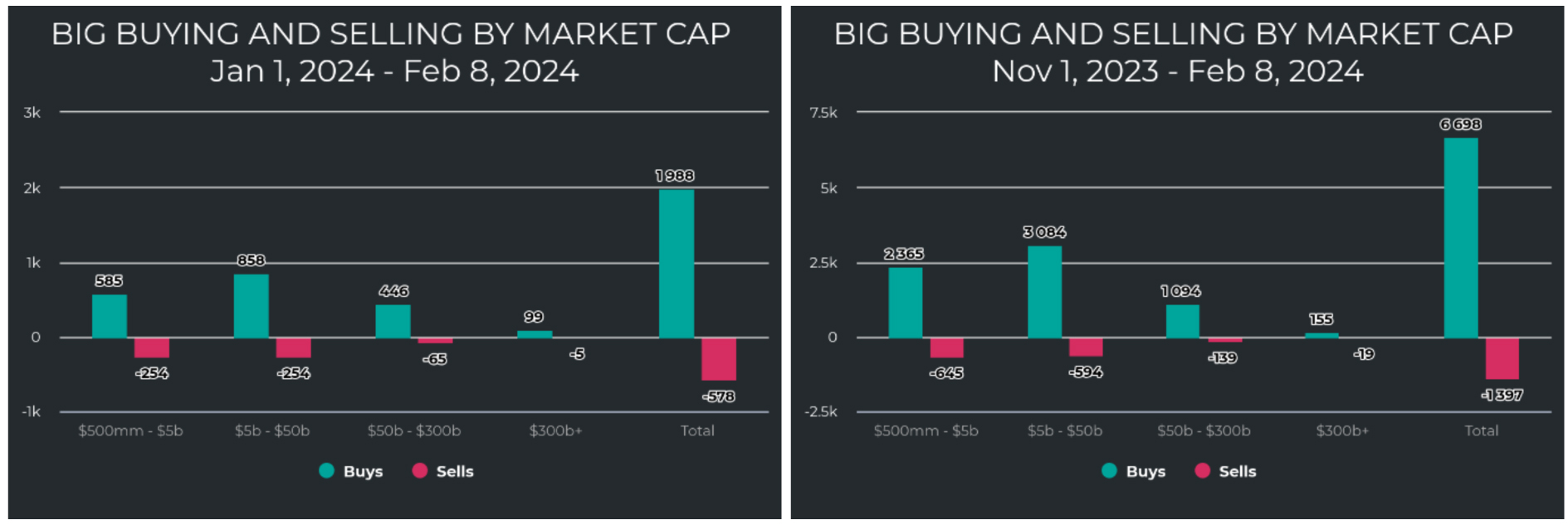
Graphs are for illustrative and discussion purposes only. Please read important disclosures at the end of this commentary.
Next, let’s look at where the leading sectors are. That has always been a great gut-check exercise for finding underlying strength. If the leading sectors are growth-heavy, that’s a very bullish sign, and that’s what we see here: Tech, Industrials, Discretionary, Financials (despite the recent regional bank woes) and Health Care are the top-5 ranked sectors. Defensive sectors are ranked near the bottom. That’s solid.
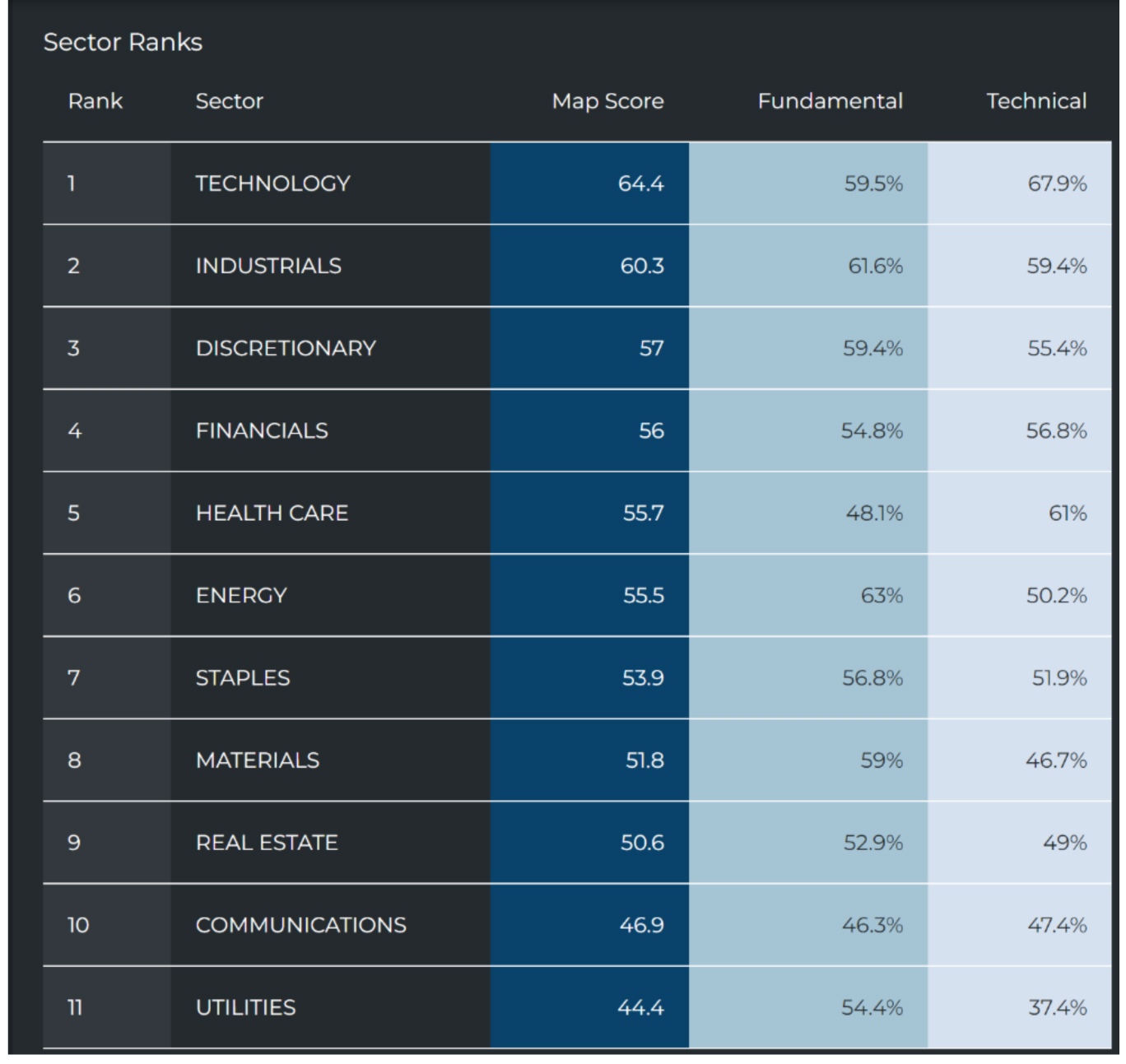
Graphs are for illustrative and discussion purposes only. Please read important disclosures at the end of this commentary.
Next, if we monitor the individual sectors for unusual buying and selling, we see no real hidden snakes in the grass just yet. Tech, Industrials, and Discretionary are seeing healthy green buying even if it curtailed from December’s outsized accumulation. But I want you to look specifically at Financials:


Graphs are for illustrative and discussion purposes only. Please read important disclosures at the end of this commentary.
Did you notice anything? Despite the sudden fear mongering headlines surrounding potential trouble with regional banks, I don’t see any unusual selling in financials yet. That says to me that smart and big money aren’t shedding bank risk just yet. In fact, the only selling I can see at the sector level is Communications. But even that’s not a red flag as that sector’s universe for stocks that can be traded by institutions easily is only 20. That universe is tiny compared to say Health Care, with 232 stocks.
I’m basically saying: Don’t stress about communications selling, because there’s no selling to speak of.
To summarize, the BMI falling from overbought is a yellow flag, but as we dig deeper under the surface, we see no red flags of deterioration other than slower buying (between Phase 1 and 2). If selling should begin, that’s just another yellow flag. It is entirely possible we can go back to overbought status if buying picks up again. For market timers, this means that contradictory information is here, so I must see more decisive action one way or another before I have any higher conviction about near-term market prices.
For the moment, I remain bullish. We can’t constantly worry about failure.
As Kobe Bryant put it, “If you’re afraid to fail, then you’re probably going to fail.”
All content above represents the opinion of Jason Bodner of Navellier & Associates, Inc.
Also In This Issue
A Look Ahead by Louis Navellier
Bull Markets Climb a Wall of Worry
Income Mail by Bryan Perry
Key Market Takeaways in a Record-Setting Week
Growth Mail by Gary Alexander
Rapid U.S. GDP Growth is Disputed by Two Other Measures
Global Mail by Ivan Martchev
The Tape is Getting a Little Stretched
Sector Spotlight by Jason Bodner
Buy, Sell, … or Do Nothing?
View Full Archive
Read Past Issues Here

Jason Bodner
MARKETMAIL EDITOR FOR SECTOR SPOTLIGHT
Jason Bodner writes Sector Spotlight in the weekly Marketmail publication and has authored several white papers for the company. He is also Co-Founder of Macro Analytics for Professionals which produces proprietary equity accumulation/distribution research for its clients. Previously, Mr. Bodner served as Director of European Equity Derivatives for Cantor Fitzgerald Europe in London, then moved to the role of Head of Equity Derivatives North America for the same company in New York. He also served as S.V.P. Equity Derivatives for Jefferies, LLC. He received a B.S. in business administration in 1996, with honors, from Skidmore College as a member of the Periclean Honors Society. All content of “Sector Spotlight” represents the opinion of Jason Bodner
Important Disclosures:
Jason Bodner is a co-founder and co-owner of Mapsignals. Mr. Bodner is an independent contractor who is occasionally hired by Navellier & Associates to write an article and or provide opinions for possible use in articles that appear in Navellier & Associates weekly Market Mail. Mr. Bodner is not employed or affiliated with Louis Navellier, Navellier & Associates, Inc., or any other Navellier owned entity. The opinions and statements made here are those of Mr. Bodner and not necessarily those of any other persons or entities. This is not an endorsement, or solicitation or testimonial or investment advice regarding the BMI Index or any statements or recommendations or analysis in the article or the BMI Index or Mapsignals or its products or strategies.
Although information in these reports has been obtained from and is based upon sources that Navellier believes to be reliable, Navellier does not guarantee its accuracy and it may be incomplete or condensed. All opinions and estimates constitute Navellier’s judgment as of the date the report was created and are subject to change without notice. These reports are for informational purposes only and are not a solicitation for the purchase or sale of a security. Any decision to purchase securities mentioned in these reports must take into account existing public information on such securities or any registered prospectus.To the extent permitted by law, neither Navellier & Associates, Inc., nor any of its affiliates, agents, or service providers assumes any liability or responsibility nor owes any duty of care for any consequences of any person acting or refraining to act in reliance on the information contained in this communication or for any decision based on it.
Past performance is no indication of future results. Investment in securities involves significant risk and has the potential for partial or complete loss of funds invested. It should not be assumed that any securities recommendations made by Navellier. in the future will be profitable or equal the performance of securities made in this report. Dividend payments are not guaranteed. The amount of a dividend payment, if any, can vary over time and issuers may reduce dividends paid on securities in the event of a recession or adverse event affecting a specific industry or issuer.
None of the stock information, data, and company information presented herein constitutes a recommendation by Navellier or a solicitation to buy or sell any securities. Any specific securities identified and described do not represent all of the securities purchased, sold, or recommended for advisory clients. The holdings identified do not represent all of the securities purchased, sold, or recommended for advisory clients and the reader should not assume that investments in the securities identified and discussed were or will be profitable.
Information presented is general information that does not take into account your individual circumstances, financial situation, or needs, nor does it present a personalized recommendation to you. Individual stocks presented may not be suitable for every investor. Investment in securities involves significant risk and has the potential for partial or complete loss of funds invested. Investment in fixed income securities has the potential for the investment return and principal value of an investment to fluctuate so that an investor’s holdings, when redeemed, may be worth less than their original cost.
One cannot invest directly in an index. Index is unmanaged and index performance does not reflect deduction of fees, expenses, or taxes. Presentation of Index data does not reflect a belief by Navellier that any stock index constitutes an investment alternative to any Navellier equity strategy or is necessarily comparable to such strategies. Among the most important differences between the Indices and Navellier strategies are that the Navellier equity strategies may (1) incur material management fees, (2) concentrate its investments in relatively few stocks, industries, or sectors, (3) have significantly greater trading activity and related costs, and (4) be significantly more or less volatile than the Indices.
ETF Risk: We may invest in exchange traded funds (“ETFs”) and some of our investment strategies are generally fully invested in ETFs. Like traditional mutual funds, ETFs charge asset-based fees, but they generally do not charge initial sales charges or redemption fees and investors typically pay only customary brokerage fees to buy and sell ETF shares. The fees and costs charged by ETFs held in client accounts will not be deducted from the compensation the client pays Navellier. ETF prices can fluctuate up or down, and a client account could lose money investing in an ETF if the prices of the securities owned by the ETF go down. ETFs are subject to additional risks:
- ETF shares may trade above or below their net asset value;
- An active trading market for an ETF’s shares may not develop or be maintained;
- The value of an ETF may be more volatile than the underlying portfolio of securities the ETF is designed to track;
- The cost of owning shares of the ETF may exceed those a client would incur by directly investing in the underlying securities; and
- Trading of an ETF’s shares may be halted if the listing exchange’s officials deem it appropriate, the shares are delisted from the exchange, or the activation of market-wide “circuit breakers” (which are tied to large decreases in stock prices) halts stock trading generally.
Grader Disclosures: Investment in equity strategies involves substantial risk and has the potential for partial or complete loss of funds invested. The sample portfolio and any accompanying charts are for informational purposes only and are not to be construed as a solicitation to buy or sell any financial instrument and should not be relied upon as the sole factor in an investment making decision. As a matter of normal and important disclosures to you, as a potential investor, please consider the following: The performance presented is not based on any actual securities trading, portfolio, or accounts, and the reported performance of the A, B, C, D, and F portfolios (collectively the “model portfolios”) should be considered mere “paper” or pro forma performance results based on Navellier’s research.
Investors evaluating any of Navellier & Associates, Inc.’s, (or its affiliates’) Investment Products must not use any information presented here, including the performance figures of the model portfolios, in their evaluation of any Navellier Investment Products. Navellier Investment Products include the firm’s mutual funds and managed accounts. The model portfolios, charts, and other information presented do not represent actual funded trades and are not actual funded portfolios. There are material differences between Navellier Investment Products’ portfolios and the model portfolios, research, and performance figures presented here. The model portfolios and the research results (1) may contain stocks or ETFs that are illiquid and difficult to trade; (2) may contain stock or ETF holdings materially different from actual funded Navellier Investment Product portfolios; (3) include the reinvestment of all dividends and other earnings, estimated trading costs, commissions, or management fees; and, (4) may not reflect prices obtained in an actual funded Navellier Investment Product portfolio. For these and other reasons, the reported performances of model portfolios do not reflect the performance results of Navellier’s actually funded and traded Investment Products. In most cases, Navellier’s Investment Products have materially lower performance results than the performances of the model portfolios presented.
This report contains statements that are, or may be considered to be, forward-looking statements. All statements that are not historical facts, including statements about our beliefs or expectations, are “forward-looking statements” within the meaning of The U.S. Private Securities Litigation Reform Act of 1995. These statements may be identified by such forward-looking terminology as “expect,” “estimate,” “plan,” “intend,” “believe,” “anticipate,” “may,” “will,” “should,” “could,” “continue,” “project,” or similar statements or variations of such terms. Our forward-looking statements are based on a series of expectations, assumptions, and projections, are not guarantees of future results or performance, and involve substantial risks and uncertainty as described in Form ADV Part 2A of our filing with the Securities and Exchange Commission (SEC), which is available at www.adviserinfo.sec.gov or by requesting a copy by emailing info@navellier.com. All of our forward-looking statements are as of the date of this report only. We can give no assurance that such expectations or forward-looking statements will prove to be correct. Actual results may differ materially. You are urged to carefully consider all such factors.
FEDERAL TAX ADVICE DISCLAIMER: As required by U.S. Treasury Regulations, you are informed that, to the extent this presentation includes any federal tax advice, the presentation is not written by Navellier to be used, and cannot be used, for the purpose of avoiding federal tax penalties. Navellier does not advise on any income tax requirements or issues. Use of any information presented by Navellier is for general information only and does not represent tax advice either express or implied. You are encouraged to seek professional tax advice for income tax questions and assistance.
IMPORTANT NEWSLETTER DISCLOSURE:The hypothetical performance results for investment newsletters that are authored or edited by Louis Navellier, including Louis Navellier’s Growth Investor, Louis Navellier’s Breakthrough Stocks, Louis Navellier’s Accelerated Profits, and Louis Navellier’s Platinum Club, are not based on any actual securities trading, portfolio, or accounts, and the newsletters’ reported hypothetical performances should be considered mere “paper” or proforma hypothetical performance results and are not actual performance of real world trades. Navellier & Associates, Inc. does not have any relation to or affiliation with the owner of these newsletters. There are material differences between Navellier Investment Products’ portfolios and the InvestorPlace Media, LLC newsletter portfolios authored by Louis Navellier. The InvestorPlace Media, LLC newsletters contain hypothetical performance that do not include transaction costs, advisory fees, or other fees a client might incur if actual investments and trades were being made by an investor. As a result, newsletter performance should not be used to evaluate Navellier Investment services which are separate and different from the newsletters. The owner of the newsletters is InvestorPlace Media, LLC and any questions concerning the newsletters, including any newsletter advertising or hypothetical Newsletter performance claims, (which are calculated solely by Investor Place Media and not Navellier) should be referred to InvestorPlace Media, LLC at (800) 718-8289.
Please note that Navellier & Associates and the Navellier Private Client Group are managed completely independent of the newsletters owned and published by InvestorPlace Media, LLC and written and edited by Louis Navellier, and investment performance of the newsletters should in no way be considered indicative of potential future investment performance for any Navellier & Associates separately managed account portfolio. Potential investors should consult with their financial advisor before investing in any Navellier Investment Product.
Navellier claims compliance with Global Investment Performance Standards (GIPS). To receive a complete list and descriptions of Navellier’s composites and/or a presentation that adheres to the GIPS standards, please contact Navellier or click here. It should not be assumed that any securities recommendations made by Navellier & Associates, Inc. in the future will be profitable or equal the performance of securities made in this report.
FactSet Disclosure: Navellier does not independently calculate the statistical information included in the attached report. The calculation and the information are provided by FactSet, a company not related to Navellier. Although information contained in the report has been obtained from FactSet and is based on sources Navellier believes to be reliable, Navellier does not guarantee its accuracy, and it may be incomplete or condensed. The report and the related FactSet sourced information are provided on an “as is” basis. The user assumes the entire risk of any use made of this information. Investors should consider the report as only a single factor in making their investment decision. The report is for informational purposes only and is not intended as an offer or solicitation for the purchase or sale of a security. FactSet sourced information is the exclusive property of FactSet. Without prior written permission of FactSet, this information may not be reproduced, disseminated or used to create any financial products. All indices are unmanaged and performance of the indices include reinvestment of dividends and interest income, unless otherwise noted, are not illustrative of any particular investment and an investment cannot be made in any index. Past performance is no guarantee of future results.
